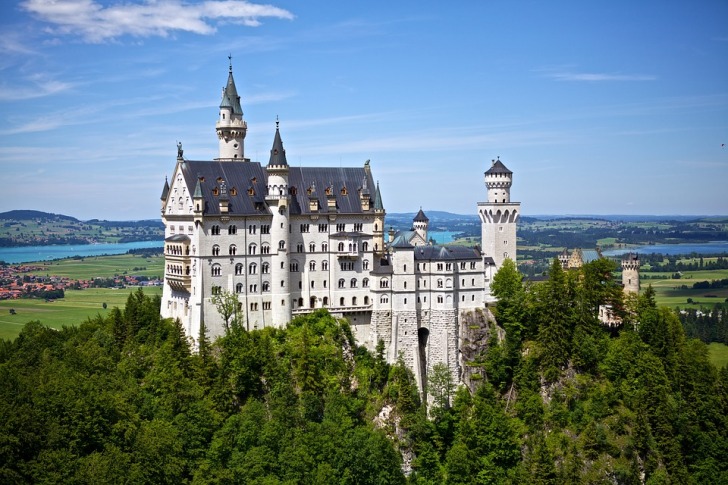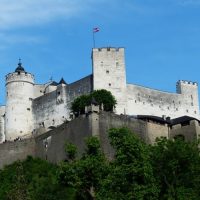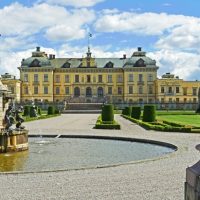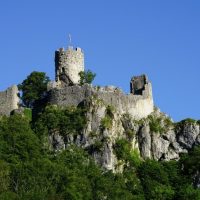For over 1,000 years, castles have been part of the European landscape.
Originally built to fortify and protect a city, eventually castles became synonymous with royalty.
Castles were where the families of the ruler of an area lived, along with a host of servants and other workers.
Basically, it was an entire village behind stone walls.
Some are now relics of the past, others are actively in use.
If you find this subject as fascinating as many others, stay tuned!
We’re going across the continent to explore the most amazing castles in Europe.
10 Most Beautiful Castles in Europe
1. Neuschwanstein Castle, Germany
This is probably the most well-known castle on the continent.
Aside from its enormous size and striking appearance, its popularity can also be attributed to Disney.
Neuschwanstein Castle was the inspiration for King Stefan’s castle from Sleeping Beauty.
It was built in 1869, and this lofty structure overlooking a cliff was actually built as a getaway so King Ludwig II could excuse himself from public life.
The castle is 65,000 square feet smack dab in the middle of the German countryside.
It is surrounded by a forest of trees and a mountain range in the background.
While it carries a fairytale appearance, much of the castle remains unfinished.
By the time the king passed away in 1886, only 14 rooms were completed.
The vision was for 200.
Today, the second floor is off-limits as it’s completely empty.
2. Hohenwerfen Fortress, Austria
Up on a hill that is alive with the sound of music and surrounded by the Alps is a 1,000-year-old castle.
Hohenwerfen Fortress overlooks a 2,000-foot drop over Werfen, Austria.
It was a passion project of Gebhard von Helfenstein, the Prince of Salzburg, an area 25 miles away.
Since it was used to protect those inside it, the castle has also been a prison and a target during multiple wars.
To get up the hill, you can walk or ride a cable car.
A ticket is required and there is usually a long line, but it does beat having to walk up the plethora of stairs.
Today, you can rent space inside Hohenwerfen Fortress for events, weddings, and even an on-screen appearance.
Hohenwerfen Fortress has been in movies, a video game, and most recently in a streaming series called The Man in the High Castle.
Tourists also have the option to tour the halls and observe the building as a museum and window into the past.
They even have live falconry demonstrations.
3. Culzean Castle, Scotland
On the west coast of Scotland is a sprawling estate once owned by the Marquess of Ailsa.
Sitting atop a large piece of land overlooking the Firth of Clyde is Culzean Castle.
Now owned and taken care of by the National Trust for Scotland, this castle has been lived in since the late 1700s.
Do you know what goes hand in hand with old castles?
Ghosts.
At least those are the stories that help drive around 350,000 visitors annually.
There are reportedly multiple spiritual beings that inhabit the estate.
If there ever was a savvy way of reminding tourists that you’re around, that was it.
In addition to its otherworldly attractions, Culzean Castle has quite a reputation for media representation.
The location has been featured in several TV and film productions, including a documentary about the Castles of Scotland.
Oh, let’s not forget that the castle was explored in a show called Most Haunted by a paranormal investigator.
4. Alcazar of Seville, Spain
Most castles were built by the nobility of some sort, but this castle is actually a royal palace.
Built for King Peter of Castile.
Before the current castle existed, there was a fort in place during the 900s by the Moors.
It wasn’t until a few centuries later that things changed a bit and the fort became what we see now.
This rebuild was a defining point for the estate. It ended the Islamic era and started the Christian one.
History is one of the reasons it’s a UNESCO World Heritage Site.
The Alcazar of Seville originally was 420,000 square feet, a lot of which is still intact today.
Like many of the other breathtaking sites, this castle has been used as a big moment for viewers.
You may recognize this as the location for the classic Lawrence of Arabia, Kingdom of Heaven, or Game of Thrones.
5. Bran Castle, Romania
While the stories around this castle may be myths, this structure is legit.
It was built in the late 1300s, and Bran Castle helped inspire Bram Stoker’s horror story, Dracula, about 500 years later.
It is the most famous landmark in Transylvania.
As much as pop culture has created a yarn that would have you believe vampires are from here, this castle was strategically picked for the novel.
The reason is, this part of Romania had several superstitions about such things as well as folk stories to perpetuate creepy things that go bump in the night.
So, to say there was a Dracula in the area wasn’t too far-fetched for the locals.
That helped create a lingering creepy attraction to Transylvania.
Thanks to all of that, the castle attracts 800,000 tourists each year.
6. Kylemore Abbey, Ireland
The abbey used to go by another name, Kylemore Castle.
Built-in 1868 by Mitchell Henry, it was a family home.
While the wealthy doctor commissioned the structure, it was his wife who purchased the land.
She first saw it during their honeymoon a couple of decades earlier.
At the time of completion, the castle was 40,000 square feet, which included 33 bedrooms.
Eventually, the family moved back to England and sold the estate to the Duke of Manchester just around the turn of the 20th century.
By 1920, the Irish Benedictine Nuns bought it and have been there ever since.
7. Pena Palace, Portugal
On a clear day, you can see Pena Palace from Lisbon, a full 20 miles away.
That’s because this gorgeous castle is not only seemingly hovering in mid-air, but it’s also very colorful.
Not to mention the unique architecture that includes a tower and domes.
Built-in the mid-1800s, Pena Palace adapted a monastery from the 1500s and added to it, creating the appearance of a Renaissance fortress.
That move was made by Queen Maria II and probably has something to do with it being a UNESCO World Heritage Site.
8. Chateau de Chambord, France
It took almost 30 years to complete the work on this French castle.
It officially opened in 1547 to much fanfare as a testament to French Renaissance architecture.
Chateau de Chambord is part of the over 13,000-acre National Hunting Reserve and overlooks the longest wall in the country, about 20 miles in length.
That wall has made the area the longest enclosed park on the continent.
Chambord Castle is the most recognizable in the world because of the style in which it was designed.
It’s so grand that it wasn’t actually completed.
That might be because it was commissioned by a king who died during construction.
Since then, ownership has changed hands several times and the castle was also abandoned for a period.
However, reconstruction eventually prevailed and now there are close to a million visitors a year.
9. Frederiksborg Castle, Denmark
King Christian IV wanted a new home. This new castle would go over a dilapidated one on the land.
Frederiksborg Castle went on to become the largest Renaissance castle in all of Scandinavia.
That sounds like the perfect place to put the National Museum of National History.
At least that’s what Denmark thought when they put it there in the late 1800s.
Visiting the castle will open you up to half a millennium of Danish history, a collection that rivals any other like it on this side of Europe.
10. Predjama Castle, Slovenia
Most spectacular castles are built to stand out.
This one was built in.
Into a cave, that is.
As Guinness World Records has stated, it’s the largest castle utilizing a cave.
At first, it can be a bit confusing to figure out why a castle was built into a cave like that.
We’re lucky enough today to even need to ask.
At the time, it was an easy choice in relation to safety.
The strategic placement of a castle makes it a good spot for defense.
The castle is at least 750 years old, which would make sense for Gothic architecture.
It was constructed for the Catholic church.
The Leugg family took possession later.
After much conflict, much of the original castle was destroyed during a battle.
Reconstruction took place at the turn of the 16th century.
An earthquake destroyed that edition, and another rebuild happened in the late 1500s.
It has had no further acts of God or battle.
If you’re going for the cave experience, that is only an option during the summer.
Bats are hibernating, you know.
Frequently Asked Questions
What's the oldest castle in Europe?
In France, Chateau de Doue la Fontaine was built in 950 CE.
This castle is still standing and is the oldest one to do just that.
There were a handful of castles erected in the years prior to the one mentioned in France, according to the ruins archeologists have come across.
However, when it comes to wholly contained buildings, Chateau de Doue la Fontaine takes the cake.
It is also believed to be the first stone castle on the continent.
What's the most visited castle in Europe?
Neuschwanstein Castle in Germany has more than 1 million visitors annually.
Lucky for us, the king of Bavaria spent an awful lot of his territory’s budget on putting this fairytale castle together.
It’s not even the only one he built, but it left quite a lasting legacy.
What country in Europe has the most castles?
For a country smaller than Montana, it’s hard to imagine that Germany has 25,000 castles.
That puts them well above every other European nation.
That’s quite a lot of space to defend, right?
Germany is overrun with these ancient structures due to the way the land was split during medieval Europe.
There were so many feudal states vying for more land and power, castles were popping up everywhere.
What's the biggest castle in Europe?
Prague Castle.
It isn’t a guess either.
The Guinness Book of World Records confirmed it.
This castle was built in the 800s to fortify the city and, about 400 years later, was turned into the home of the royal family.
In total, it’s still over 200,000 square feet.












Castles have been a part of European history for over 1,000 years and continue to fascinate people today.
Neuschwanstein Castle in Germany is a fairytale-like structure with stunning views, but much of it remains unfinished.